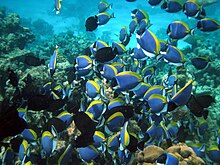Acanthurus leucosternon
| Powder-blue surgeonfish | |
|---|---|

| |
| Scientific classification | |
| Domain: | Eukaryota |
| Kingdom: | Animalia |
| Phylum: | Chordata |
| Class: | Actinopterygii |
| Order: | Acanthuriformes |
| Family: | Acanthuridae |
| Genus: | Acanthurus |
| Species: | A. leucosternon
|
| Binomial name | |
| Acanthurus leucosternon E. T. Bennett, 1833
| |
Acanthurus leucosternon is a marine tropical fish belonging to the surgeonfish family, Acanthuridae. Its common names are powder blue tang and powder-blue surgeonfish.
Description
The fish can reach an average size of 23 cm (9 in) in length.[2] The body has an oval shape and is compressed laterally. Like other surgeonfishes, Acanthurus leucosternon swims with its pectoral fins. The caudal fin has a crescent shape. The fish has a "surgeon's scalpel," an erected part of the spine located at the base of the tail.[3] The mouth is small and pointed in a beak-like manner with tiny and sharp teeth for reaching narrow spaces of food.[4] Its sides are blue;[4] its dorsal fin and the base of caudal fin are yellow;[4] the head is black;[4] the mouth, the throat area, the anal and pelvic fins are white.[5] The pectoral fins are transparent with yellow reflections. The intensity of its blue color shows off if the fish is healthy or not.[citation needed] The fish does not undergo color changes as it matures; as some tangs, surgeonfish and unicornfish do.
Distribution and habitat
Acanthurus leucosternon is found in tropical waters from the Indian Ocean.[6] The species inhabits shallow and clear coastal waters always associated with a reef. It prefers flat top reefs and areas along seaward slopes.[6]
Behaviour
The powder blue tang, like most fish in the family Acanthuridae, is herbivorous, eating mostly benthic algae.[7] Acanthurus leucosternon has a diurnal activity. It is solitary, territorial and aggressive with other surgeonfish.[2] In cases where food is plentiful, it may feed in shoals, but in cases of scarcity, it may compete individually for food.[4] It may use its surgeon's scalpel as a defensive weapon.[2]
Economic value

The powder blue tang is rarely harvested for anything other than the marine aquarium industry. It is a commonly sold fish that is moderately difficult to care for, although its popularity is easily exceeded by the regal tang and yellow tang.[citation needed] They are very prone to Cryptocaryon irritans.[2] They are reef safe and are compatible with most species except other species of fish in the genus Acanthurus.[2]
References
- ^ Abesamis, R.; Clements, K.D.; McIlwain, J.; Myers, R.; Nanola, C.; Rocha, L.A.; Russell, B.; Stockwell, B. (2012). "Acanthurus leucosternon". IUCN Red List of Threatened Species. 2012: e.T178000A1516737. doi:10.2305/IUCN.UK.2012.RLTS.T178000A1516737.en. Retrieved 27 December 2021.
- ^ a b c d e Lougher, Tristan (2006). What Fish?: A Buyer's Guide to Marine Fish. Interpet Publishing. p. 111. ISBN 0-7641-3256-3.
- ^ Clipperton, John (1 September 2013). "Powder Blue Tang – Acanthurus leucosternon". Marine Habitat magazine. Fish Junkies Ltd. Archived from the original on 14 February 2014. Retrieved 13 February 2014.
- ^ a b c d e DK Publishing (17 January 2011). Animal Life: Secrets of the Animal World Revealed. DK Publishing. p. 188. ISBN 978-0-7566-8886-8.
- ^ Andreas Vilcinskas, La vie sous-marine des tropiques, Vigot, 2002, 475 p. (ISBN 2711415252), p. 366
- ^ a b "Facts about Powder Blue Tang (Acanthurus leucosternon) - Encyclopedia of Life". Eol.org. Retrieved 2014-01-04.
- ^ Froese, Rainer; Pauly, Daniel (eds.) (2004). "Acanthurus leucosteron" in FishBase. January 2004 version.
Further reading
- Robertson, Ross; Polunin, Nicholas; Leighton, Kimberley (1979). "The behavioral ecology of three Indian Ocean surgeonfishes (Acanthurus lineutus, A. leucosternon and Zebrusoma scopes): their feeding strategies, and social and mating systems". Environmental Biology of Fishes. 4 (2): 125–170. doi:10.1007/BF00005448.

